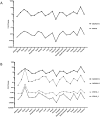Differential regulation of non-protein coding RNAs from Prader-Willi Syndrome locus
- PMID: 25246219
- PMCID: PMC4171697
- DOI: 10.1038/srep06445
Differential regulation of non-protein coding RNAs from Prader-Willi Syndrome locus
Abstract
Prader-Willi Syndrome (PWS) is a neurogenetic disorder caused by the deletion of imprinted genes on the paternally inherited human chromosome 15q11-q13. This locus harbours a long non-protein-coding RNA (U-UBE3A-ATS) that contains six intron-encoded snoRNAs, including the SNORD116 and SNORD115 repetitive clusters. The 3'-region of U-UBE3A-ATS is transcribed in the cis-antisense direction to the ubiquitin-protein ligase E3A (UBE3A) gene. Deletion of the SNORD116 region causes key characteristics of PWS. There are few indications that SNORD115 might regulate serotonin receptor (5HT2C) pre-mRNA processing. Here we performed quantitative real-time expression analyses of RNAs from the PWS locus across 20 human tissues and combined it with deep-sequencing data derived from Cap Analysis of Gene Expression (CAGE-seq) libraries. We found that the expression profiles of SNORD64, SNORD107, SNORD108 and SNORD116 are similar across analyzed tissues and correlate well with SNORD116 embedded U-UBE3A-ATS exons (IPW116). Notable differences in expressions between the aforementioned RNAs and SNORD115 together with the host IPW115 and UBE3A cis-antisense exons were observed. CAGE-seq analysis revealed the presence of potential transcriptional start sites originated from the U-UBE3A-ATS spanning region. Our findings indicate novel aspects for the expression regulation in the PWS locus.
Figures





References
-
- Runte M. et al. The IC-SNURF-SNRPN transcript serves as a host for multiple small nucleolar RNA species and as an antisense RNA for UBE3A. Hum Mol Genet 10, 2687–2700 (2001). - PubMed
-
- Lee S., Walker C. L. & Wevrick R. Prader-Willi syndrome transcripts are expressed in phenotypically significant regions of the developing mouse brain. Gene Expr Patterns 3, 599–609 (2003). - PubMed
Publication types
MeSH terms
Substances
LinkOut - more resources
Full Text Sources
Other Literature Sources
Medical
Miscellaneous

